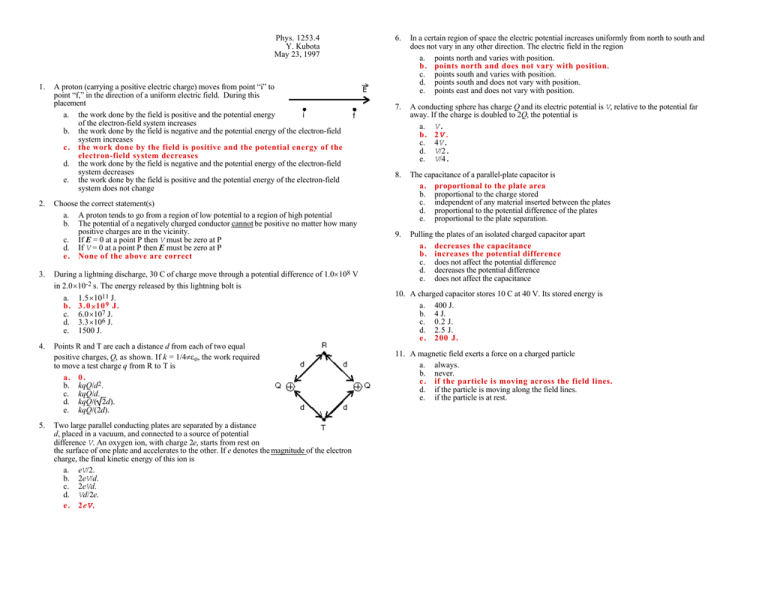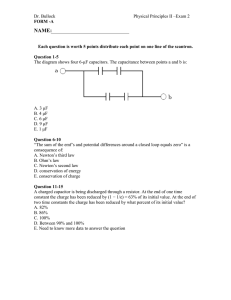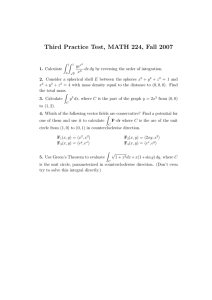MC 3 key
advertisement

Phys. 1253.4 Y. Kubota May 23, 1997 1. 2. 3. 4. 5. A proton (carrying a positive electric charge) moves from point “i” to point “f,” in the direction of a uniform electric field. During this placement a. the work done by the field is positive and the potential energy of the electron-field system increases b. the work done by the field is negative and the potential energy of the electron-field system increases c . the work done by the field is positive and the potential energy of the electron-field system decreases d. the work done by the field is negative and the potential energy of the electron-field system decreases e. the work done by the field is positive and the potential energy of the electron-field system does not change Choose the correct statement(s) a. A proton tends to go from a region of low potential to a region of high potential b. The potential of a negatively charged conductor cannot be positive no matter how many positive charges are in the vicinity. c. If E = 0 at a point P then V must be zero at P d. If V = 0 at a point P then E must be zero at P e . None of the above are correct During a lightning discharge, 30 C of charge move through a potential difference of 1.0×108 V in 2.0×10-2 s. The energy released by this lightning bolt is a. 1.5×1011 J. b. 3 . 0 10 9 J. c. 6.0×107 J. d. 3.3×106 J. e. 1500 J. Points R and T are each a distance d from each of two equal positive charges, Q, as shown. If k = 1/4πεo, the work required to move a test charge q from R to T is a. 0 . b. kqQ/d2. c. kqQ/d. d. kqQ/( 2d). e. kqQ/(2d). Two large parallel conducting plates are separated by a distance d, placed in a vacuum, and connected to a source of potential difference V. An oxygen ion, with charge 2e, starts from rest on the surface of one plate and accelerates to the other. If e denotes the magnitude of the electron charge, the final kinetic energy of this ion is a. eV/2. b. 2eV/d. c. 2eVd. d. Vd/2e. e . 2eV. 6. In a certain region of space the electric potential increases uniformly from north to south and does not vary in any other direction. The electric field in the region a. points north and varies with position. b. points north and does not vary with position. c. points south and varies with position. d. points south and does not vary with position. e. points east and does not vary with position. 7. A conducting sphere has charge Q and its electric potential is V, relative to the potential far away. If the charge is doubled to 2Q, the potential is a. V. b. 2V. c. 4V. d. V/2. e. V/4. 8. The capacitance of a parallel-plate capacitor is a. proportional to the plate area b. proportional to the charge stored c. independent of any material inserted between the plates d. proportional to the potential difference of the plates e. proportional to the plate separation. 9. Pulling the plates of an isolated charged capacitor apart a. decreases the capacitance b. increases the potential difference c. does not affect the potential difference d. decreases the potential difference e. does not affect the capacitance 10. A charged capacitor stores 10 C at 40 V. Its stored energy is a. 400 J. b. 4 J. c. 0.2 J. d. 2.5 J. e . 200 J. 11. A magnetic field exerts a force on a charged particle a. always. b. never. c . if the particle is moving across the field lines. d. if the particle is moving along the field lines. e. if the particle is at rest. 12. An electron and a proton each travel with equal speeds around circular orbits in the same uniform magnetic field, as shown in the diagram. The field is into the page on the diagram. Because the electron is less massive than the proton and because the electron is negatively charged and the proton is positively charged a. the electron travels clockwise around the smaller circle and the proton travels counterclockwise around the larger circle. b. the electron travels counterclockwise around the smaller circle and the proton travels clockwise around the larger circle c. the electron travels clockwise around the larger circle and the proton travels counterclockwise around the smaller circle d. the electron travels counterclockwise around the larger circle and the proton travels clockwise around the smaller circle e. the electron travels counterclockwise around the smaller circle and the proton travels counterclockwise around the larger circle 13. An electron is travelling in the +x direction. A uniform electric field E is in the −y direction. If a uniform magnetic field with the appropriate magnitude and direction also exists in the region, the total force on the electron will be zero. The appropriate direction for the magetic field is a. the +y direction. b. the −y direction. c . into the page. d. out of the page. e. the −x direction. 14. The current is from left to right in the conductor shown. The magnetic field is into the page and point S is at a higher potential than point T. The charge carriers are a. positive. b. negative. c. neutral. d. absent. e. moving near the speed of light. 15. The figure shows a uniform magnetic field B directed to the left and a wire carrying a current into the page. The magnetic force acting on the wire is a. toward the top of the page. b. toward the bottom of the page. c. toward the left. d. zero. e. none of the above. 16. A current is clockwise around the outside edge of this page and a uniform magnetic field is directed parallel to the page, from left to right. If the magnetic force is the only force acting on the page, the torque on the page will point a. to the right. b. to the left. c. out of the page. d. into the page. e . to the bottom. 17. Charge Q is distributed uniformly throughout a spherical insulating shell. The net electric flux due to this charge through the outer surface of the shell is a. 0. b. Q/ o . c. 2Q/ o. d. Q/2 o. e. Q/4π o. 18. The resistance of resistor 1 is twice the resistance of resistor 2 (R 1 = 2R 2). The two are connected in series and a potential difference is maintained across the combination. Then a. the current in 1 is twice that in 2 (I1 = 2I2). b. the current in 1 is half that in 2 (I1 = I2/2). c . the potential difference across 1 is twice that across 2 (V 1 = 2V 2 ) . d. the potential difference across 1 is half that across 2 (V 1 = V 2/2). e. none of the above are true. V R1 R2




